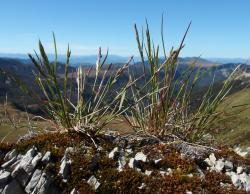- Taxon
- Gallery
Dense tufts to 60 cm with culms often much overtopping the densely, very minutely scabrid leaves; branching intravaginal. Leaf-sheath 2–5–(8) cm, firmly membranous, grey-brown to light greenish brown, sometimes reddish, very densely minutely papillose or minutely scabrid to pubescent, sometimes glabrous. Ligule 0.8–1 mm, truncate, erose, sparsely finely ciliate. Collar sometimes with a few stiff hairs to 1.5 mm. Leaf-blade (3)–12–25–(30) cm × (0.5)–1–4 mm, folded with inrolled margins or flat, hard, dull green or reddish, abaxially scabrid with very dense minute prickle-teeth, or smooth, or sparsely scabrid above, adaxially ribbed with dense fine minute prickle-teeth or minutely densely pubescent on ribs; margins finely scabrid. Culm 10–40 cm, internodes glabrous or finely pubescent above, rarely pilose, or minutely prickle-toothed below panicle. Panicle 5–20 × 1–1.5–(3) cm, lanceolate, with short, inconspicuous branches, ± interrupted, not very dense, rarely more open, but spikelets clustered and individually inconspicuous; rachis, branches, and pedicels very densely minutely strigose or rarely puberulous. Spikelets 6–8 mm, light green often tinged reddish brown. Glumes unequal, membranous, keels with minute prickle-teeth in upper ½; lower c. ¾ length of upper, narrow oblong to narrow ovate, upper ¾ to ≈ spikelet, elliptic-oblong; margins broadly hyaline, sparsely prickle-toothed near acute to acuminate sometimes mucronate tip. Lemma 3.5–6 mm, bidentate or sometimes bicuspid, papillose, minutely prickle-toothed near midnerve; awn 3.5–7.5 mm, recurved, insertion in upper ¼ of lemma. Palea minutely prickle-toothed on keels almost throughout and on margins near tip. Callus hairs to 1 mm. Rachilla hairs to 2 mm. Lodicules 0.8–1.2 mm, glabrous. Anthers 0.8–1.5–(2) mm. Gynoecium: ovary c. 0.8 mm; stigma-styles c. 1.2 mm. Caryopsis 2.5–3 × 0.7–0.8 mm.
[From: Edgar and Connor (2000) Flora of New Zealand. Volume 5 (second printing).]




